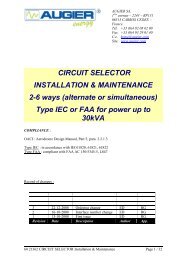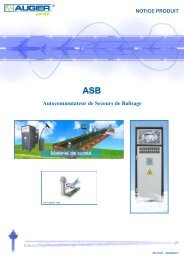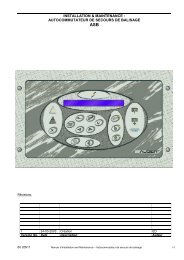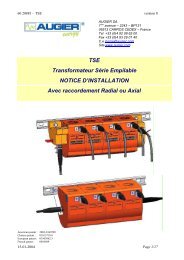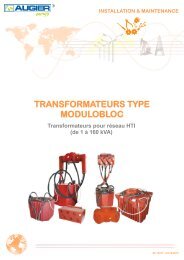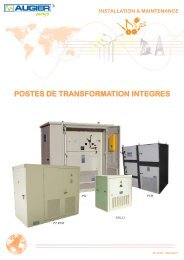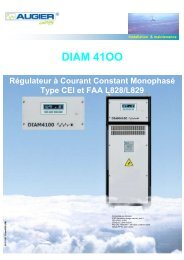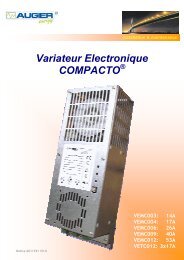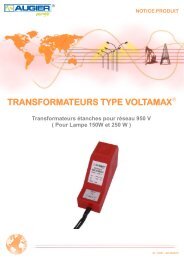TIT Installation Conception - Augier
TIT Installation Conception - Augier
TIT Installation Conception - Augier
Create successful ePaper yourself
Turn your PDF publications into a flip-book with our unique Google optimized e-Paper software.
MEDIUM VOLTAGE ENERGY<br />
TRANSMISSION SYSTEM<br />
THOUGHTS ON THE DISTRIBUTION<br />
OF ELECTRICAL ENERGY<br />
T I T<br />
GENERAL LEAFLET<br />
1<br />
60 10062 - 13/07/2011
CONTENTS<br />
GENERAL :<br />
The receivers………………………………………………………………………………. p. 4<br />
Network transformer in a pit or compact substation………………………………………. p. 4<br />
The LV sub network………………………………………………………………………..p. 5<br />
The <strong>TIT</strong> transportation network…………………………………………………………… p. 6<br />
Earthing scheme…………………………………………………………………………… p. 7<br />
Pipes calculation……………………………………………………….……….…………..p. 9<br />
Transformer substation…………………………………………………………………..…p. 10<br />
Dimmer……………………………………………………………………………………. p. 10<br />
<strong>TIT</strong> network control ………………………………………………………………..………p. 10<br />
TOOLS :……………………………………………………………………………………. p. 11<br />
APPLICATION EXAMPLE :…………………………………………………..………… p. 12<br />
APPENDIX :<br />
Number of lamps per <strong>TIT</strong> / LV network transformer………………………….…………….. p. 18<br />
Choice of the LV cable section………………………………….…………………………… p. 19<br />
Dimensions of prefab concrete pits………………………………………….……………….. p. 20<br />
Choice of MV cable section…………………………………………………………………. p. 21<br />
Appearing impedance of MV and LV cables…………………………………………….….. p. 23<br />
Voltage drop calculation……………………………………………………………………... p. 24<br />
Choice guide of transportation voltage level to supply an end of line load………………….. p. 26<br />
Choice of 950 V cable section………………………………………………………………... p. 29<br />
LV : Low Voltage.<br />
MLV : Maximum Low Voltage.<br />
HCP : High Cutting Power.<br />
MV : Medium Voltage.<br />
NP : Nominal Power.<br />
<strong>TIT</strong> : Gathers MLV and MV Voltages<br />
GLOSSARY<br />
Standards : NFC 17-200 from March 2007, NFC 52-410 from 1978<br />
This document is not an exhaustive study, but is merely a collection of observations and advice aimed at aiding<br />
specialists.<br />
<strong>Augier</strong> takes no responsability for use of advice on all previous and future installations.<br />
3
GENERAL :<br />
The Receiver :<br />
<strong>TIT</strong> <strong>Installation</strong> <strong>Conception</strong><br />
The types of power receivers can be very varied. The parameters below are used to characterize them. Some are<br />
directly associated with the type of power receiver and so do not need to be recorded.<br />
The type of receiver.<br />
Power supply voltage and tolerances.<br />
Phase system (single or three phase).<br />
Power rating, start-up characteristics (overcurrent, cycle and duration).<br />
The type of use: continuous, cyclic or occasional.<br />
The conditions for simultaneous operation and simultaneous start-up of several power receivers, if<br />
necessary, both in steady state and at start-up.<br />
The degree of continuous operation requirement.<br />
NETWORK TRANSFORMER IN A PIT OR COMPACT SUBSTATION :<br />
In the chapter below, the transformers of network or mini substation will be called "step down sub-station ".<br />
The step down sub-station is used to supply a power receiver or group of power receivers.<br />
The locations of the step down sub-stations and the configuration of the power receivers are determined according to<br />
conditions in the field, relating to installation of these stations and laying of LV lines, by an economic optimization<br />
calculation that takes into account the costs of the stations and LV cables, as well as the installation costs.<br />
The step down station’s power rating is determined by adding together the power of the supplied power receivers. In<br />
addition the following factors will be taken into account :<br />
Power efficiencies and factors, accessory power consumption, and possibly an incrementation factor, to<br />
determine the theoretical current.<br />
Permissible limits for power supply voltage when operating in steady state and at start-up.<br />
Ambient temperature conditions.<br />
The current/voltage characteristics of the power consumers, the predictable deterioration in electrical<br />
efficiency due to ageing, the possible extensions, to determine a working current.<br />
The start-up characteristics to define a start-up current, possibly after application of an incrementation<br />
factor.<br />
The coupling of the step down transformer will be single or three phase, depending on the design of the LV<br />
sub-network (see below).<br />
4
There are two possible types of step down sub-station, depending on its power and installation conditions :<br />
Either a TED step down station, normally installed as infrastructure in an inspection pit (power lim-<br />
ited to 160 kVA). This is an operational complete unit, equipped with two plug-in <strong>TIT</strong> terminals to<br />
ensure line continuity to the downstream sub-station, comprising the <strong>TIT</strong>/LV transformer, the <strong>TIT</strong> and<br />
LV protection, and the LV output which can be either a 6 meters cable or a plug-in terminal.<br />
Pits of watertight transformers must offer an inside volume at least equal to four times the transformer volume. In<br />
addition, they must allow cable inputs and their connection with respect to curving radius values indicated by the<br />
cable constructor.<br />
Transformers’ pits can be prefab. They must be composed of a grill equipped with a locking device by a special<br />
screw, which forbids the access to the transformer until the <strong>TIT</strong> input is not opened at the installation origin, put<br />
in circuit breaker and on earth (according to NF C 17 200 standard for road lighting installations).<br />
Or a compact internal or external station, depending on the installation conditions, comprising a dry varnish<br />
impregnated transformer.<br />
Outdoor type compact substations are designed to be installed on a concrete base, with cable output and input<br />
from the ground, under plastic wrapping.<br />
The step down sub-stations are equipped with the following electrical protection :<br />
MV side : one or more fuses whose rating(s) is/are determined according to the characteristics of the step down<br />
transformer.<br />
However this protection will only be installed when there are several <strong>TIT</strong>/LV sub-stations linked to a step up<br />
station, because otherwise it is impossible to ensure selectivity with the step up transformer’s <strong>TIT</strong> protection.<br />
LV side : The LV circuit breaker whose rating must be greater than the working current of the supplied power<br />
receivers.<br />
In the transformer : thermal probes connected to the LV circuit breaker.<br />
THE LV SUB-NETWORK<br />
Its layout depends on the terrain’s characteristics, the road layout, the possibilities for underground crossings, the<br />
locations of natural or man-made obstacles.<br />
A ground scheme must be chosen in accordance with current legislation and the continuous operation<br />
requirements. A certain number of rules will be defined as a result of this choice.<br />
These rules will determine whether or not it is necessary to install differential protection or insulation monitoring<br />
devices on the step down station, and to determine the cross-section of the LV cables, called LV feeders.<br />
These rules are defined in a general way in the standard NF C 15-100 and when appropriate also in specialized<br />
standards such as C 17200 or the C 17-205 guide for public lighting.<br />
They guarantee :<br />
Feeder protection against excess current<br />
Personnel protection against indirect contacts<br />
5
Concerning short circuit protection, as described in standard NF C 15-100 (art. 435-1 and 533-3 comments), the LV<br />
circuit breaker of the step down sub-station that ensures overcharge protection is also considered to provide short<br />
circuit protection at the same time.<br />
For road lighting installations, the C 17-205 practical guide nevertheless recommends that the minimum short-circuit<br />
rule should be satisfied, and suggests possible reductions in the line cross-section without any additional protection<br />
device.<br />
The LV sub-network of a step down sub-station as we have designed it does not comprise any reduction in<br />
cross-section, and so the case described in guide C 17-205 does not concern us.<br />
Let us consider for a moment the possibility that a short-circuit is not detected by the magnetothermal tripping<br />
device, therefore creating a continuous fault.<br />
In such a case the thermal probe protection installed in our <strong>TIT</strong>/LV sub-stations is capable of eliminating the fault,<br />
regardless of whether or not it is dangerous for the LV feeders.<br />
Given these considerations, it is not necessary to satisfy the minimum short-circuit rule, concerning LV networks<br />
supplied via TED type or compact type step down transformers.<br />
THE <strong>TIT</strong> TRANSPORTATION NETWORK<br />
The number of outputs, their layout :<br />
They are determined according to the planned locations for the different <strong>TIT</strong>/LV substations, the possibilities<br />
offered by the terrain for trench excavation, road crossings and civil engineering works.<br />
As far as possible we will make every effort to achieve balanced outputs, and when appropriate we will consider the<br />
possibility of looping-in 2 outputs together, for repair purposes.<br />
Any given output can be implemented as a single antenna, or with T branches or in a cross.<br />
The <strong>TIT</strong> transmission network obtained in this way can also be linear type, star, loop or meshed, or a combination of<br />
these different types.<br />
The general output characteristics :<br />
The output phase system must be three phase, in order to power the three phase <strong>TIT</strong>/LV sub-stations.<br />
In this case, the preferred <strong>TIT</strong> voltage will be 6600 V, 5500 V or 950 V.<br />
It should be noted that single phase <strong>TIT</strong>/LV sub-stations can however be installed on this type of output. The<br />
transformers corresponding to this configuration comprise a phase selector making it possible to balance the output<br />
charge distribution on the three phases.<br />
If the <strong>TIT</strong>/LV sub-stations are all single phase, the output can be single phase or three phase.<br />
In most cases, the single phase solution with a preferential voltage of 3200 V or 950 V is the most economic and the<br />
easiest to implement. However, when the outputs are of a considerable length, the three phase solution with single<br />
phase <strong>TIT</strong>/LV sub-stations can be selected, to reduce line drop and generally satisfy all the rules stipulated in the<br />
standards.<br />
6
Earthing scheme :<br />
The scheme will be chosen from the TNRC or TNRS schemes, that in general are the most suitable (defined in<br />
conformity with standard UTE D17 200). The neutral <strong>TIT</strong> is linked directly to ground at the installation origin.<br />
When the outputs are single phase either scheme can be selected, and the only difference is that in the TNRC<br />
scheme the <strong>TIT</strong> neutral is grounded at each <strong>TIT</strong>/LV substation, and in the TNRS scheme it is not.<br />
If the outputs are three phase the ground scheme has to be TNRS, since the neutral is not distributed.<br />
The earth connections must be made :<br />
Individual earth connections.<br />
Connection to a bare copper conductor with à minimum cross section of 25 mm² which serves as both the earth<br />
connection and an equipotential link between the luminaires.<br />
Common earth point with the luminaires connected by insulated cables.<br />
The second solution, the earth network for bonding the equipment earths comprises a bare copper conductor with a<br />
minimum cross sectional area of 25 mm² burried directly in the ground corresponding to the <strong>TIT</strong> line, is the one we<br />
recommend because it allows to obtain better resistance to earth values.<br />
Since the 1 st of October 2003, the NC C 17 200 standard imposes this second solution for road lighting.<br />
The earthing circuit this way will enable to connect :<br />
The earth point of the <strong>TIT</strong>/LV transformer.<br />
The neutral of <strong>TIT</strong> winding in a generalised earth scheme (TNR-C).<br />
The safety grid in the transformer housing.<br />
One point of the low voltage.<br />
The conducting parts of any equipment that can be accessed at the same time as that of the road lighting<br />
system.<br />
For the substation, the earth connection must be a bare conductor 25 mm² made of copper buried at about 50 cm<br />
from substation.<br />
This conductor will be depth of about 40 cm, the iron framework of the station concrete pedestal being, in that case,<br />
linked to this conductor.<br />
The transformer neutral must be connected to the earth connection to realise a TN scheme.<br />
The substation earth bonding must be connected to the earth connection :<br />
The earths of all circuits in the substation.<br />
The screens of the cable.<br />
The transformer tank.<br />
The switching devices.<br />
The metal pipework and ducting.<br />
However, the doors of the building and the metal ventilation slots should not intentionally be bonded.<br />
7
CALCULATION OF FEEDER CROSS SECTION :<br />
This calculation will be determined by the maximum authorized voltage drop, by adding together the values<br />
from the <strong>TIT</strong> and LV voltage drops. The total voltage drop must not exceed 6% for a road lighting installation, and<br />
8% in other cases.<br />
However it will be necessary to check that the protection fuse located at the circuit origin (at the step up station)<br />
makes it possible to satisfy the stipulated rules, i.e.:<br />
Protection against indirect contacts.<br />
Protection against over charges.<br />
Protection against excess current.<br />
If necessary a differential relay can be installed, if a TNRS scheme is used, to make it easier to satisfy the rules<br />
mentioned above.<br />
9
THE SUBSTATION :<br />
The substation will be step up or step down type.<br />
Implementation :<br />
As far as possible, the substation will be installed in the center of the installation. However, installation off-center<br />
is perfectly acceptable when an <strong>TIT</strong> transmission voltage is used.<br />
The implementation will be determined according to the possibilities for installation offered by the site.<br />
Nominal Power :<br />
Nominal power is determined by the sum of step-down sub-station powers, taking into account the extension<br />
possibility or non-project and by retaining a standardized transformer power.<br />
Step-up stations will be used for powers from 5 to 160 kVA for easy projects, with most often, only one <strong>TIT</strong> net-<br />
work departure.<br />
Step-down stations will be used for powers from 160 to 1250 kVA which intensities are compatible with the circuit<br />
breaking bearing of pluggable terminals of step-down watertight transformers.<br />
For service continuity reasons, it is possible to retain a transformation station equipped with two identical power<br />
transformers. One transformer supplies the whole installation in case of the failure of one of the transformers.<br />
Coupling:<br />
The type of step-up transformer coupling depends on which phase system is selected for the <strong>TIT</strong> outputs.<br />
In the case of three phase outputs, it will be three phase.<br />
In the case of single phase outputs, it can be three phase, three/two phase, three/single phase or single phase:<br />
Three phase can be selected if there are three outputs or a multiple of three. These outputs must be vir-<br />
tually balanced.<br />
Three/two phase will be selected if there are two outputs or a multiple of two. These outputs must be<br />
virtually balanced.<br />
Three/single phase is the only coupling that corresponds to all the possible situations and that allows<br />
looping of 2 outputs for repair. It implies that the primary currents will not be balanced.<br />
<strong>TIT</strong> networks control :<br />
For networks only composed with lamps, inputs will be temporary, off during the day, controlled by a photo<br />
electrical cell doubled with an astronomical clock. The control will also be realizable by current carrier using the<br />
STEP II system.<br />
For networks supplying receivers different from lamps, inputs will be permanent.<br />
For mixt networks, inputs will be permanentthe lighting control will be made by current carrier.<br />
Dimmer :<br />
It is better to put, in the transformer station, a dimmer regulator to reduce the power of lamps during weak traffic<br />
hours.The dimmer regulator allows, during hours when reduction happens, consumption savings.<br />
10
TOOLS :<br />
In the appendix, you will find all the documentation to help you with the realization of a quick <strong>TIT</strong> study :<br />
Case of the supplying of receiver units at a line end :<br />
The guide for the choice of the voltage level transportation to supply the end of line load.<br />
Case of the supplying of receivers uniformally spread, road lighting case :<br />
Annex : number of lamps for each <strong>TIT</strong>/LV lighting transformer.<br />
Choice of the LV cable section downstream of the step-down watertight transformer.<br />
Concrete prefab pits best dimensions for step-down transformers installation.<br />
Choice of the MV cable secton for single-phase and three-phase networks, for a 2 or 3 % voltage drop.<br />
Choice of the MLV cable section for single-phase and three-phase networks, uniformally spread load at the end<br />
of the line.<br />
Calculation formula enabling to control the choices with the annex usage and AUGIER.<br />
11
APPLICATION EXAMPLE :<br />
SUPPLY FOR A ROAD LIGHTING « LV/<strong>TIT</strong> » INSTALLATION<br />
PROJECT :<br />
In the following section, by means of an example we show how to determine rapidly the main sections constituting<br />
a preliminary study for a road lighting project using <strong>TIT</strong> transmission voltage.<br />
We draw the reader’s attention to the need to check or further specify the results obtained using the method set out<br />
below. This is because, apart from the approximate nature of this example, it is not intended to provide an answer<br />
for every situation or for every special case that may arise.<br />
The aim of the project we have used in this example is to define the power supply for road lighting of a road.<br />
Determination of the basis for calculation :<br />
The calculations are to be performed on the basis of the information to be supplied below :<br />
Number of power consumers and type : the installation comprises one lighting pole every 35 m, each<br />
fitted with two 250W high pressure sodium lamps.<br />
<strong>Installation</strong> of the lighting poles : The lighting poles are set up in the central reservation.<br />
Network length : The total length of the installation is 4 km.<br />
Station location : The station is located in the middle of the installation.<br />
Supplied voltage level : Three phase 400 V<br />
<strong>Installation</strong> conditions : Maximum ambient temperature 40°C<br />
Altitude less than 1000 meters<br />
Internal installation<br />
Operating principle :<br />
This substation will be supplied from a low voltage three phase 400 V power source, via the mains<br />
network, and will transform this voltage into a transmission voltage to be determined.<br />
STEP 1 : Determination of the network’s rating power :<br />
Determination of number of the lamps :<br />
The installation’s power is determined by the number and type of the lamps used, whose mean characteristics<br />
are described in guide C 17 205.<br />
Application :<br />
Number of lamps : 230<br />
Type and power : 250 W HPS<br />
Determination of the road lighting transformers’ power :<br />
Their power depends on the number of lamps powered by the network transformer.<br />
The transformers are used in conformity with standard NFC 52-410, which limits their use to 0.8x NP where<br />
NP is the nominal power.<br />
12
As a rule we will use transformers with :<br />
3 kVA in exchangers where the lamps will be distributed in all directions.<br />
5 kVA for the current sections.<br />
10 kVA for the pole power supplies.<br />
Other power supplies available according to use.<br />
The number of lamps supplied by a transformer is given in our table « Number of lamps by transformers <strong>TIT</strong>/LV »<br />
LAMPS TYPE HPS LAMPS<br />
Power (W) 70 100 150 250 400 600 1000 2000<br />
Power (VA) 104 138 196 322 506 713 1242 2310<br />
TRANSFORMER POWER RATING NUMBER OF LAMPS BY TRANSFORMER<br />
Nominal power Using power<br />
400 VA 320 VA 3 2 1 1<br />
630 VA 500 VA 5 3 2 1 1<br />
1 kVA 0,8 kVA 8 5 4 2 1 1<br />
2 kVA 1,6 kVA 16 11 8 5 3 2 1<br />
3 kVA 2,4 kVA 24 17 12 7 4 3 2 1<br />
5 kVA 4 kVA 40 29 20 12 8 5 3 1<br />
10 kVA 8 kVA 25 16 11 6 3<br />
Application :<br />
5 kVA with a maximum of 12 lamps HPS 250 W<br />
<strong>TIT</strong> NETWORK<br />
35 m<br />
Substation<br />
<strong>TIT</strong>/LV 5 kVA<br />
Determination of the network’s total power :<br />
The total power depends on the number of network transformers<br />
Application :<br />
20 network step-down transformers 5 kVA, total power = 100 kVA.<br />
STEP 2 : Determination of the low voltage cable cross-section :<br />
In general, the TN ground scheme will be used.<br />
12 x HPS 250 W<br />
Substation<br />
<strong>TIT</strong>/LV 5 kVA<br />
The cable cross-section depends on :<br />
The length of the low voltage sub-network seen from the transformer side, for a transformer placed in the<br />
middle.<br />
On the protector block rating (LV circuit breaker).<br />
13
The cable section is shown in the « Low voltage cross section determination »<br />
Application :<br />
Rating power<br />
Maximum length (m) for one side of the transformer<br />
Protected against indirect contacts with 1 extr. MALT<br />
(kVA) Cross section (mm²)<br />
4 6 10 16 25<br />
0,4 552 774 1143 1561 2000<br />
0,63 552 774 1143 1561 2000<br />
1 552 774 1143 1561 2000<br />
2 345 484 714 976 1250<br />
3 276 387 571 780 1000<br />
4 221 310 457 624 800<br />
5 172 242 357 488 625<br />
6 138 194 286 390 500<br />
8 155 229 312 400<br />
10 181 248 317<br />
Length of the LV sub-network on one side of the transformer : 87.5 meters + 5 meters vertical section per pole.<br />
Total length = 102.5 meters. The cable cross section is 2 x 4 mm².<br />
<strong>TIT</strong> Network<br />
35 m<br />
102,5m<br />
Substaion <strong>TIT</strong>/LV<br />
5 kVA<br />
12 x HPS 250 W<br />
Substation <strong>TIT</strong>/LV<br />
5 kVA<br />
LV Câble 2x 4mm²<br />
STEP 3 : Determination of the distribution type and level of transmission voltage :<br />
The distribution may be :<br />
Three phase 5500 V for long charged networks, or networks that comprise three phase power receivers.<br />
Single phase 3200 V for power values up to 100 kVA, for installations that only have one output.<br />
Two phase 3200 V for power values up to 100 kVA, for installations with two balanced outputs (2 x 50 kVA).<br />
Application :<br />
The substation is placed in the center of the application with 50 kVA to supply on each side. Two phase 3200 V<br />
distribution.<br />
STEP 4 : Determination and selection of Road lighting Transformers :<br />
The transformers are determined according to :<br />
The transformer coupling.<br />
The type of distribution network (single phase or three phase) .<br />
The type of cable used.<br />
14
Application :<br />
Single phase transformer for single phase network, using two pole concentric cable TER MM, TED MMX or<br />
Modulo BI type.<br />
Please refer to the transformer documentation available.<br />
STEP 5 : Determination of the MV cable cross-section<br />
The choice of cable cross-section depends on the power and length of the network.<br />
The length is basically limited by the line drop.<br />
Protection is ensured by choosing a protection.<br />
The cross-section is given in appendix « MV cable cross section determination », which takes into account a<br />
maximum MV line drop of 2%, compatible with the total limit of 6% for MV and LV.<br />
Power Rating<br />
Cross section (mm²)<br />
(kVA) 6 10 16 25<br />
30 1750 2890 4580 7260<br />
40 1310 2170 3435 5445<br />
50 1050 1735 2750 4355<br />
60 875 1445 2290 3630<br />
70 750 1240 1960 3110<br />
80 655 1080 1720 2720<br />
Application :<br />
The 3200 V cable cross section for supply 50 kVA per output on the Length 2000 meters is 16 + 16 mm².<br />
Single phase network 3200 V<br />
35 m<br />
Step 6 : Determination of the substation :<br />
Determination of the substation power :<br />
Two pole concentric cable 16 +16 mm²<br />
TED MMX 5 KVA<br />
3200 V/230 V<br />
12 x HPS 250 W<br />
TED MMX 5 KVA<br />
3200 V/230 V<br />
LV Cable 2x4 mm²<br />
The main transformer’s power must be at least equal to the sum of the nominal powers of the road lighting<br />
transformers, supplied downstream (NFC 17-200).<br />
We will choose a standard power, chosen in the range : 25, 50, 63, 80, 100, 125, or 160 kVA<br />
Application :<br />
In order to have an extension possibility, the retained power is 125 kVA.<br />
15
The substation will be equipped with :<br />
A LV counting table.<br />
A step-up set protection and control table.<br />
A power transformer, three-two phases, 400 V/3200 V with a 125 kVA power rating.<br />
The different features that constitute the protection table are determined depending on the transformer’s<br />
characteristics and dimensioned during the definitive study.<br />
Conclusion :<br />
This fore-study enables to difine the heights conforming to NFC 17-200 et NFC 52-410 standards with respect to a<br />
global voltage drop of 6% maximum.<br />
All the features of the fore-study, will have to be confirmed by a more precise calculation, in order to also precise and<br />
confirm the values obtained.<br />
Indeed, for our application, the 3200 V cable section retained would be 10+10 mm².<br />
16
APPENDIX<br />
17
NUMBER OF LAMPS FOR EACH <strong>TIT</strong>/LV NETWORK TRANSFORMER :<br />
Determination of the maximum number of lamps to use depending on the transformers power, conforming to the<br />
standard recommendations NFC 17-200, NFC 52-410 and C 17-205 guide.<br />
TYPE OF LAMPS HIGH PRESSURE SODIUM LAMPS MERCURY LAMPS<br />
Power Rating (W) 70 100 150 250 400 600 1000 2000 125 250 400 700<br />
Power Rating (VA) 104 138 196 322 506 713 1242 2310 161 310 495 886<br />
TRANSFORMER<br />
POWER RATING<br />
Nominal Power Useful Load<br />
NUMBER OF LAMPS PER TRANSFORMER<br />
400 VA 320 VA 3 2 1 1 2 1<br />
630 VA 500 VA 5 3 2 1 1 3 1 1<br />
1 KVA 0,8 kVA 8 5 4 2 1 1 5 2 1<br />
2 KVA 1,6 kVA 16 11 8 5 3 2 1 10 5 3 1<br />
3 KVA 2,4 kVA 24 17 12 7 4 3 2 1 15 7 5 2<br />
5 KVA 4 kVA 40 29 20 12 8 5 3 1 25 13 8 4<br />
10 KVA 8 kVA 25 16 11 6 3 25 16 9<br />
TYPE OF LAMPS LOW PRESSURE SODIUM LAMPS METALLIC IODIZED LAMPS<br />
Power Rating (W) 26 35 55 91 131 250 400 1000 2000<br />
Power Rating (VA) 37 51 78 113 152 322 506 1242 2369<br />
TRANSFORMER<br />
POWER RATING<br />
P. Nominale P. utile<br />
NUMBER OF LAMPS PER TRANSFORMER<br />
400 VA 320 VA 8 6 4 2 2 1<br />
630 VA 500 VA 13 9 6 4 3 1 1<br />
1 KVA 0,8 kVA 21 15 10 7 5 2 1<br />
2 KVA 1,6 kVA 43 31 20 14 10 5 3 1<br />
3 KVA 2,4 kVA 30 21 15 7 4 2 1<br />
5 KVA 4 kVA 35 26 12 8 3 1<br />
10 KVA 8 kVA 25 16 6 3<br />
For information :<br />
Lamps lifespan is about 8 000 to 10 000 hours.<br />
The lighting functionning time, in France, is 4 085 hours.<br />
18
DETERMINATION OF THE LOW VOLTAGE CABLE CROSS SECTION :<br />
Single-phase network transformer<br />
Maximum lengths in meters of the pipes, single-phase 230 V, TN scheme, with the windings edge linked to the<br />
earth, protected against indirect contacts and overloads. Case of single-phase transformers protected by a circuit-<br />
breaker associated with a thermical probe.<br />
Calculations established with a protection conductor of 1 x 25 mm².<br />
Power<br />
Rating<br />
(kVA)<br />
Intensity (A)<br />
Under 230 V<br />
Protection rating Low<br />
voltage<br />
Maximum length (m) one side of the transformer<br />
Protected against indirect contacts with an earthing plug edge<br />
Section (mm²)<br />
4 6 10 16 25<br />
0.4 1.74 C60 N - 10 A (B) 552 774 1143 1561 2000<br />
0.63 2.74 C60 N - 10 A (B) 552 774 1143 1561 2000<br />
1 4.35 C60 N - 10 A (B) 552 774 1143 1561 2000<br />
2 8.70 C60 N - 16 A (B) 345 484 714 976 1250<br />
3 13.04 C60 N - 20 A (B) 276 387 571 780 1000<br />
4 17.39 C60 N - 25 A (B) 221 310 457 624 800<br />
5 21.74 C60 N - 32 A (B) 172 242 357 488 625<br />
6 26.09 C60 N - 40 A (B) 138 194 286 390 500<br />
8 34.78 C60 N - 50 A (B) 155 229 312 400<br />
10 43.48 C60 N - 63 A (B)<br />
181 248 317<br />
Non standard section<br />
Maximum lengths (in meters) of single-phase pipes in scheme TN, protected against indirect contacts :<br />
L = k U S / (R (1+m)Ind With : k = 0,8<br />
U = 230 V<br />
S = LV cable section<br />
R = 0,023<br />
m = S / 25<br />
Ind = 5 x circuit-breaker rating<br />
Maximum lengths (in meters) of single-phase pipes in scheme TN, protected against circuit breakings :<br />
In the case of transformers protected by a circuit-breaker associated to a thermical probe, rule not to be verified.<br />
L = K U S / (2 Rcc ind) With : K = 0,8<br />
Rcc = 0,023 (Protection by circuit-breaker)<br />
Ind = 5 x circuit-breaker rating<br />
19
DIMENSIONS OF CONCRETE PITS<br />
Depending on the existing pit, for TER, TED and MODULOBLOC<br />
Transformer<br />
Power<br />
Rating<br />
TED MMX 0,4 à 6 kVA<br />
Modulobloc bi or tri jusqu’à 6 kVA<br />
TER MM ou MT 1 à 10 kVA<br />
TED MMX 8 et 10 kVA<br />
TED MTT 2 à 10 kVA<br />
Modulobloc bi or tri 8 et 10 kVA<br />
Every TED type<br />
With elbow terminals<br />
or modulobloc<br />
16 à 32<br />
kVA<br />
Dimensions (inside) concrete pits (mm) Approx.<br />
L l H<br />
Weight (kg)<br />
Models<br />
800 800 887 900 EP 80<br />
1000 800 887 1100 EP 100<br />
1790 880 1200 3000 L5T<br />
INDICATIVE DIMENSIONS OF CONCRETE PITS<br />
Minimum dimensions (with a 3x25 mm² cable) for TED > 10 kVA and TEH<br />
Transformer<br />
Power<br />
Rating<br />
TED MMX 16 kVA<br />
TED TTT 5 - 10 kVA<br />
TED MMX 25 kVA<br />
TED MTT 16 - 25 kVA<br />
TED TTT 16 kVA<br />
TED MMX 25 kVA<br />
TED MTT 50 kVA<br />
TED TTT 25 - 32 kVA<br />
Concrete pits dimensions (mm)<br />
L W H (b. straight) H (b. elbowed)<br />
1300 750 1300 1050<br />
1450 800 1350 1150<br />
1700 900 1500 1300<br />
TEH TTT 50 kVA 1700 900 1600 1400<br />
TEH TTT 80 - 100 kVA 1900 1000 1700 1500<br />
20
DETERMINATION OF THE MV CABLE CROSS SECTION<br />
3200 V single-phase network<br />
Compatible with a 2 % voltage drop :<br />
Uniformally spread power rating, maximum network departure lengths in meters.<br />
Cross Section (mm²)<br />
Power Rating 6 10 16 25<br />
(kVA)<br />
Impedance at 85 °C<br />
3.9 2.36 1.49 0.94<br />
20 2626 4339 6872 10894<br />
30 1750 2893 4582 7262<br />
40 1313 2169 3436 5447<br />
50 1050 1736 2749 4357<br />
60 875 1446 2291 3631<br />
70 750 1240 1964 3112<br />
80 656 1085 1718 2723<br />
90 583 964 1527 2421<br />
100 525 868 1374 2179<br />
110 477 789 1250 1981<br />
120 438 723 1145 1816<br />
130 404 668 1057 1676<br />
140 620 982 1556<br />
150 579 916 1452<br />
160 542 859 1362<br />
170 510 809 1282<br />
180 482 764 1210<br />
190 457 723 1147<br />
200 434 687 1089<br />
210 655 1037<br />
220 625 990<br />
230 598 947<br />
240 573 908<br />
Compatible with a 3 % voltage drop :<br />
Uniformally spread power rating, maximum network departure lengths in meters.<br />
Power Rating<br />
Cross Section (mm²)<br />
kVA 6 10 16 25<br />
20 3938 6508 10309 16340<br />
30 2626 4339 6872 10894<br />
40 1969 3254 5154 8170<br />
50 1575 2603 4123 6536<br />
60 1313 2169 3436 5447<br />
70 1125 1860 2945 4669<br />
80 985 1627 2577 4085<br />
90 875 1446 2291 3631<br />
100 788 1302 2062 3268<br />
110 716 1183 1874 2971<br />
120 656 1085 1718 2723<br />
130 606 1001 1586 2514<br />
140 563 930 1473 2334<br />
150 525 868 1374 2179<br />
160 492 814 1289 2043<br />
170 463 766 1213 1922<br />
180 438 723 1145 1816<br />
190 415 685 1085 1720<br />
200 651 1031 1634<br />
210 620 982 1556<br />
220 592 937 1485<br />
230 566 896 1421<br />
240 542 859 1362<br />
21
Compatible with a 4 % voltage drop :<br />
Uniformally spread power rating, maximum input lengths in meters.<br />
Cross Section (mm²)<br />
Power Rating 6 10 16 25<br />
(kVA)<br />
Impedance at 85 °C<br />
3.9 2.36 1.49 0.94<br />
20 5251 8678 13745 21787<br />
30 3501 5785 9163 14525<br />
40 2626 4339 6872 10894<br />
50 2101 3471 5498 8715<br />
60 1750 2893 4582 7262<br />
70 1500 2479 3927 6225<br />
80 1313 2169 3436 5447<br />
90 1167 1928 3054 4842<br />
100 1050 1736 2749 4357<br />
110 955 1578 2499 3961<br />
120 875 1446 2291 3631<br />
130 808 1335 2115 3352<br />
140 750 1240 1964 3112<br />
150 700 1157 1833 2905<br />
160 656 1085 1718 2723<br />
170 618 1021 1617 2563<br />
180 583 964 1527 2421<br />
190 553 913 1447 2293<br />
200 868 1374 2179<br />
210 826 1309 2075<br />
220 789 1250 1981<br />
230 755 1195 1895<br />
240 723 1145 1816<br />
Three-phase 5500 V network, compatible with a 2% voltage drop<br />
Cross Section (mm²)<br />
Power Rating 6 10 16 25 35 50<br />
(kVA)<br />
Impedance at 85 °C<br />
3.9 2.36 1.49 0.94 0.66 0.46<br />
50 6205 10254 16242 25745<br />
100 3103 5127 8121 12872 18333 26304<br />
120 2585 4273 6767 10727 15278 21920<br />
140 2216 3662 5801 9195 13095 18789<br />
160 1939 3204 5076 8045 11458 16440<br />
180 1724 2848 4512 7151 10185 14614<br />
200 1551 2564 4060 6436 9167 13152<br />
220 1410 2331 3691 5851 8333 11957<br />
240 1293 2136 3384 5363 7639 10960<br />
260 1193 1972 3123 4951 7051 10117<br />
280 1108 1831 2900 4597 6548 9394<br />
300 1034 1709 2707 4291 6111 8768<br />
320 1602 2538 4023 5729 8220<br />
340 1508 2388 3786 5392 7737<br />
360 1424 2256 3576 5093 7307<br />
380 1349 2137 3387 4825 6922<br />
400 1282 2030 3218 4583 6576<br />
420 1221 1934 3065 4365 6263<br />
440 1165 1846 2926 4167 5978<br />
460 1115 1765 2798 3986 5718<br />
480 1692 2682 3819 5480<br />
500 1624 2574 3667 5261<br />
630 1289 2043 2910 4175<br />
22
Three-phase 5500 V network, compatible with a 3% voltage drop<br />
Cross Section (mm²)<br />
Power Rating 6 10 16 25 35 50<br />
(kVA)<br />
Impedance at 85 °C<br />
3,9 2,36 1,49 0,94 0,66 0,46<br />
50 9308 15381 24362 38617<br />
100 4654 7691 12181 19309<br />
120 3878 6409 10151 16090 22917 32880<br />
140 3324 5493 8701 13792 19643 28183<br />
160 2909 4807 7613 12068 17188 24660<br />
180 2585 4273 6767 10727 15278 21920<br />
200 2327 3845 6091 9654 13750 19728<br />
220 2115 3496 5537 8777 12500 17935<br />
240 1939 3204 5076 8045 11458 16440<br />
260 1790 2958 4685 7426 10577 15176<br />
280 1662 2747 4350 6896 9821 14092<br />
300 1551 2564 4060 6436 9167 13152<br />
320 1454 2403 3807 6034 8594 12330<br />
340 1369 2262 3583 5679 8088 11605<br />
360 1293 2136 3384 5363 7639 10960<br />
380 1225 2024 3206 5081 7237 10383<br />
400 1163 1923 3045 4827 6875 9864<br />
420 1108 1831 2900 4597 6548 9394<br />
440 1058 1748 2768 4388 6250 8967<br />
460 1672 2648 4198 5978 8578<br />
480 1602 2538 4023 5729 8220<br />
500 1538 2436 3862 5500 7891<br />
630 1221 1934 3065 4365 6263<br />
Three-phase 5500 V network, compatible with a 4% voltage drop<br />
Cross Section (mm²)<br />
Power Rating 6 10 16 25 35 50<br />
(kVA)<br />
Impedance at 85 °C<br />
3,9 2,36 1,49 0,94 0,66 0,46<br />
50 12410 20508 32483 51489<br />
100 6205 10254 16242 25745<br />
120 5171 8545 13535 21454 30556<br />
140 4432 7324 11601 18389 26190<br />
160 3878 6409 10151 16090 22917 32880<br />
180 3447 5697 9023 14303 20370 29227<br />
200 3103 5127 8121 12872 18333 26304<br />
220 2821 4661 7383 11702 16667 23913<br />
240 2585 4273 6767 10727 15278 21920<br />
260 2387 3944 6247 9902 14103 20234<br />
280 2216 3662 5801 9195 13095 18789<br />
300 2068 3418 5414 8582 12222 17536<br />
320 1939 3204 5076 8045 11458 16440<br />
340 1825 3016 4777 7572 10784 15473<br />
360 1724 2848 4512 7151 10185 14614<br />
380 1633 2698 4274 6775 9649 13844<br />
400 1551 2564 4060 6436 9167 13152<br />
420 1477 2441 3867 6130 8730 12526<br />
440 1410 2331 3691 5851 8333 11957<br />
460 2229 3531 5597 7971 11437<br />
480 2136 3384 5363 7639 10960<br />
500 2051 3248 5149 7333 10522<br />
630 1628 2578 4086 5820 8351<br />
23
MV cables :<br />
LV AND MV CABLES APPEARING IMPEDANCE<br />
Table valid for concentric bipolar and tripolar cables.<br />
Given values for cables calculated at an average temperature of 50 °C.<br />
LV Cables :<br />
Cross Section (mm²) Impedance ( / km)<br />
6 3.41<br />
10 2.03<br />
16 1.28<br />
25 0.81<br />
35 0.58<br />
50 0.41<br />
Table valid for armed LV bipolar and tripolar cables.<br />
Given values for cables calculated at an average temperature of 65 °C.<br />
Cross Section (mm²)<br />
Impedance ( / km)<br />
4 4.4<br />
6 2.96<br />
10 1.78<br />
16 1.15<br />
25 0.743<br />
35 0.551<br />
50 0.421<br />
70 0.309<br />
24
1/ LV Side Voltage Drop : ULV<br />
1/a) LV Single Phase Network :<br />
ULV = 2 L i (n (n + 1) / 2) Z<br />
ULV % = U / 230 (V)<br />
VOLTAGE DROP CALCULATION<br />
i (A) : rated current of one pole i.e. = P(VA) * q / 230 (V) with q : number of lamps per pole<br />
and P : power of one lamp<br />
L (km) : inter-distance length between each lighting pole, plus 5 meters cable to reach the pole.<br />
n : Number of poles on the side of the network transformer.<br />
Z ( / km) : LV cable impedance.<br />
1/b) LV Three-phase Network :<br />
ULV = 3 L3 (i*3) (n3 (n3 + 1 ) / 2) Z<br />
ULV % = U / 400 (V)<br />
i (A) : Rated current of one pole i.e. = P (VA) * q / 230 (V) with q : number of lamps per pole<br />
and P : power of one lamp.<br />
L3 : Inter-distance between groups of three poles => for example l3 = 3*L + 0,005.<br />
n3 : Number of poles in group of three.<br />
25
2/ MV Network Voltage Drop : Umv<br />
2/a) TER or TED Type transformers (MV/LV) are regularly distributed in the network<br />
A-TER MM or TED MMX :<br />
Umv = L I (n(n+1)/2) Z<br />
Umv %= Umv / 3200 (V)<br />
I(A) : Intensity for a tranformer calculated on its nominal power in kVA : I=P / 3200 (V).<br />
L (km) : Interdistance between each transformer.<br />
n : Number of transformer.<br />
Z (Ω / km) : MV cable impedance.<br />
B– TER MT or TED MTT :<br />
Umv = 3 (3 * L) (3 * I) (n3 (n3 + 1) / 2) Z<br />
Umv %= Umv / 5500 (V)<br />
I (A) : Current of one transformer according to P (VA) calculated as I = P / 5500 (V).<br />
L (km) : Inter-distance length between each transformer.<br />
n3 : Number of transformers in group of 3.<br />
Z ( / km) : IHV cable impedance.<br />
C– TER TT or TED TTT :<br />
Umv = 3 L I (n (n + 1) / 2) Z<br />
Umv %= Umv / 5500 (V)<br />
I (A) : Current of one transformer according to P(VA) calculated as : I = P / (5500 * 3).<br />
L (km) : Inter-distance length between each transformer.<br />
n : Number of transformers.<br />
Z ( / km) : MV cable impedance.<br />
2/b) Deliver of power to a distance of L (km) three-phase network :<br />
Umv = 3 L I Z<br />
Umv % = Umv / 5500 (V)<br />
I (A) : Current of the network I = P / (5500* 3).<br />
Z ( / km) : MV cable impedance.<br />
L (km) : Distance between the supplier and the receiver.<br />
Please note :<br />
The power rating mentioned is the sum of the network transformers power rating. In the case of the<br />
network transformers load is reduced , we can use the sum of the power rating of the supplied lamps<br />
counting a coefficient of around 15 %.<br />
26
Way of using the power supply range graph.<br />
These graphs help you to find quickly the right solution for the supply of a single load.<br />
The graph inputs are the distances of the load and its power.<br />
With these parameters, you obtain the voltage level to use and the wire section.<br />
Example :<br />
We have several receptors to supply at 3480 meters far. Their power are respectively 10,20,30 and 50 kVA.<br />
You have to report on the graph the cross between the 10 kVA line and the 3480 meters line. It is in the area for<br />
mono 3200V with a wire section of 6 mm². This is the best solution. You can also notice that it is under the<br />
non-continuous line for mono 950V 35mm² wire section. It means this solution is technically working but<br />
economically less profitable than medium voltage. It will be use only if we absolutely want to use low voltage. As<br />
for the 20 kVA receptors, the only solution is 3200V wire section 6 mm². Then for 30 kVA, we use 10 mm² as wire<br />
section and 16 mm² for the 50 kVA receiver.<br />
Comment on the graphs.<br />
The drawing represent the technical limit for each kind of solution to respect a maximal voltage drop of %.<br />
All the area under the drawing respect this condition.<br />
The colored areas correspond to domain were the use af a solution is the more accurate.<br />
For distance shorter than 500m the graph are not valid.<br />
The non-continuous drawing represent the limit for a technically working solution but not profitable.<br />
27
End of line single-phase loads<br />
28
End of line three-phase loads<br />
29
DETERMINATION OF THE 950 V CABLE SECTION<br />
950 V single-phase network uniformally spread power :<br />
Compatible with a 2% voltage drop :<br />
Maximum input length in meters.<br />
Power Rating<br />
(kVA)<br />
Cross Section<br />
(mm²)<br />
6<br />
Length (m)<br />
10 16 25 35<br />
Z (85°)<br />
I(A)<br />
3,19 1,919 1,24 0,8 0,595<br />
10 10,53 566 941 1456 2256 3034<br />
16 16,84 354 588 910 1410 1896<br />
25 26,32 226 376 582 903 1213<br />
32 33,68 177 294 455 705 948<br />
50 52,63 113 188 291 451 607<br />
63 66,32 90 149 231 358 482<br />
80 84,21 71 118 182 282 379<br />
100 105,26 57 94 146 226 303<br />
Compatible with a 3% voltage drop :<br />
Maximum input length in meters.<br />
Power Rating<br />
(kVA)<br />
Cross Section<br />
(mm²)<br />
6<br />
Length (m)<br />
10 16 25 35<br />
Z (85°) 3,19 1,919 1,24 0,8 0,595<br />
I(A)<br />
10 10,53 849 1411 2183 3384 4550<br />
16 16,84 530 882 1365 2115 2844<br />
25 26,32 339 564 873 1354 1820<br />
32 33,68 265 441 682 1058 1422<br />
50 52,63 170 282 437 677 910<br />
63 66,32 135 224 347 537 722<br />
80 84,21 106 176 273 423 569<br />
100 105,26 85 141 218 338 455<br />
Compatible with a 4% voltage drop :<br />
Maximum input length in meters.<br />
Power Rating<br />
(kVA)<br />
Cross Section<br />
(mm²)<br />
6<br />
Length (m)<br />
10 16 25 35<br />
Z (85°)<br />
I(A)<br />
3,19 1,919 1,24 0,8 0,595<br />
10 10,53 1132 1881 2911 4513 6067<br />
16 16,84 707 1176 1820 2820 3792<br />
25 26,32 453 752 1165 1805 2427<br />
32 33,68 354 588 910 1410 1896<br />
50 52,63 226 376 582 903 1213<br />
63 66,32 180 299 462 716 963<br />
80 84,21 141 235 364 564 758<br />
100 105,26 113 188 291 451 607<br />
30
950 V three-phase network uniformally spread power :<br />
Compatible with a 2% voltage drop :<br />
Maximum input length in meters.<br />
Power Rating<br />
(kVA)<br />
Cross Section<br />
(mm²)<br />
6<br />
Length (m)<br />
10 16 25 35<br />
Z (85°) 3,19 1,919 1,24 0,8 0,595<br />
I (A)<br />
10 6,08 1132 1881 2911 4513 6067<br />
16 9,72 707 1176 1820 2820 3792<br />
25 15,19 453 752 1165 1805 2427<br />
32 19,45 354 588 910 1410 1896<br />
50 30,39 226 376 582 903 1213<br />
63 38,29 180 299 462 716 963<br />
80 48,62 141 235 364 564 758<br />
100 60,78 113 188 291 451 607<br />
Compatible with a 3% voltage drop :<br />
Maximum input length in meters.<br />
Power Rating<br />
(kVA)<br />
Cross Section<br />
(mm²)<br />
6<br />
Length (m)<br />
10 16 25 35<br />
Z (85°)<br />
I (A)<br />
3,19 1,919 1,24 0,8 0,595<br />
10 6,08 1697 2822 4367 6769 9101<br />
16 9,72 1061 1764 2729 4230 5688<br />
25 15,19 679 1129 1747 2708 3640<br />
32 19,45 530 882 1365 2115 2844<br />
50 30,39 339 564 873 1354 1820<br />
63 38,29 269 448 693 1074 1445<br />
80 48,62 212 353 546 846 1138<br />
100 60,78 170 282 437 677 910<br />
Compatible with a 4% voltage drop :<br />
Maximum input length in meters.<br />
Power Rating<br />
(kVA)<br />
Cross Section<br />
(mm²)<br />
6<br />
Length (m)<br />
10 16 25 35<br />
Z (85°)<br />
I (A)<br />
3,19 1,919 1,24 0,8 0,595<br />
10 6,08 2263 3762 5823 9025 12134<br />
16 9,72 1415 2351 3639 5641 7584<br />
25 15,19 905 1505 2329 3610 4854<br />
32 19,45 707 1176 1820 2820 3792<br />
50 30,39 453 752 1165 1805 2427<br />
63 38,29 359 597 924 1433 1926<br />
80 48,62 283 470 728 1128 1517<br />
100 60,78 226 376 582 903 1213<br />
31
End of line 950 V single-phase network load :<br />
Compatible with a 3% voltage drop :<br />
Maximum input lengths in meters :<br />
Power Rating<br />
(kVA)<br />
Cross Section<br />
(mm²)<br />
6<br />
Length (m)<br />
10 16 25 35<br />
Z (85°)<br />
I(A)<br />
3,19 1,919 1,24 0,8 0,595<br />
5 5,26 849 1411 2183 3384 4550<br />
10 10,53 424 705 1092 1692 2275<br />
16 16,84 265 441 682 1058 1422<br />
25 26,32 170 282 437 677 910<br />
32 33,68 133 220 341 529 711<br />
50 52,63 85 141 218 338 455<br />
63 66,32 67 112 173 269 361<br />
80 84,21 53 88 136 212 284<br />
100 105,26 42 71 109 169 228<br />
Compatible with a 4% voltage drop :<br />
Maximum input lengths in meters :<br />
Power Rating<br />
(kVA)<br />
Compatible with a 5% voltage drop :<br />
Maximum input lengths in meters :<br />
Cross Section<br />
(mm²)<br />
6<br />
Length (m)<br />
10 16 25 35<br />
Z (85°) 3,19 1,919 1,24 0,8 0,595<br />
I(A)<br />
5 5,26 1132 1881 2911 4513 6067<br />
10 10,53 566 941 1456 2256 3034<br />
16 16,84 354 588 910 1410 1896<br />
25 26,32 226 376 582 903 1213<br />
32 33,68 177 294 455 705 948<br />
50 52,63 113 188 291 451 607<br />
63 66,32 90 149 231 358 482<br />
80 84,21 71 118 182 282 379<br />
100 105,26 57 94 146 226 303<br />
Power Rating<br />
(kVA)<br />
Cross Section<br />
(mm²)<br />
6<br />
Length (m)<br />
10 16 25 35<br />
Z (85°)<br />
I(A)<br />
3,19 1,919 1,24 0,8 0,595<br />
5 5,26 1415 2351 3639 5641 7584<br />
10 10,53 707 1176 1820 2820 3792<br />
16 16,84 442 735 1137 1763 2370<br />
25 26,32 283 470 728 1128 1517<br />
32 33,68 221 367 569 881 1185<br />
50 52,63 141 235 364 564 758<br />
63 66,32 112 187 289 448 602<br />
80 84,21 88 147 227 353 474<br />
100 105,26 71 118 182 282 379<br />
32
End of line 950 V three-phase network load :<br />
Compatible with a 3% voltage drop :<br />
Maximum input lengths in meters :<br />
Power Rating<br />
(kVA)<br />
Cross Section<br />
(mm²)<br />
6<br />
Length (m)<br />
10 16 25 35<br />
Z (85°) 3,19 1,919 1,24 0,8 0,595<br />
I (A)<br />
5 3,04 1697 2822 4367 6769 9101<br />
10 6,08 849 1411 2183 3384 4550<br />
16 9,72 530 882 1365 2115 2844<br />
25 15,19 339 564 873 1354 1820<br />
32 19,45 265 441 682 1058 1422<br />
50 30,39 170 282 437 677 910<br />
63 38,29 135 224 347 537 722<br />
80 48,62 106 176 273 423 569<br />
100 60,78 85 141 218 338 455<br />
Compatible with a 4% voltage drop :<br />
Maximum input lengths in meters :<br />
Power Rating<br />
(kVA)<br />
Compatible with a 5% voltage drop :<br />
Maximum input lengths in meters :<br />
Power Rating<br />
(kVA)<br />
Cross Section<br />
(mm²)<br />
6<br />
Length (m)<br />
10 16 25 35<br />
Z (85°) 3,19 1,919 1,24 0,8 0,595<br />
I (A)<br />
5 3,04 2263 3762 5823 9025 12134<br />
10 6,08 1132 1881 2911 4513 6067<br />
16 9,72 707 1176 1820 2820 3792<br />
25 15,19 453 752 1165 1805 2427<br />
32 19,45 354 588 910 1410 1896<br />
50 30,39 226 376 582 903 1213<br />
63 38,29 180 299 462 716 963<br />
80 48,62 141 235 364 564 758<br />
100 60,78 113 188 291 451 607<br />
Cross Section<br />
(mm²)<br />
6<br />
Length (m)<br />
10 16 25 35<br />
Z (85°) 3,19 1,919 1,24 0,8 0,595<br />
I (A)<br />
5 3,04 2829 4703 7278 11281 15168<br />
10 6,08 1415 2351 3639 5641 7584<br />
16 9,72 884 1470 2274 3525 4740<br />
25 15,19 566 941 1456 2256 3034<br />
32 19,45 442 735 1137 1763 2370<br />
50 30,39 283 470 728 1128 1517<br />
63 38,29 225 373 578 895 1204<br />
80 48,62 177 294 455 705 948<br />
100 60,78 141 235 364 564 758<br />
33
PERSONAL NOTES<br />
34
PERSONAL NOTES<br />
35
AUGIER IS CERTIFIED ISO 9001 SINCE 1995<br />
With constant improvements, the manufacturer may alter information without prior warning




